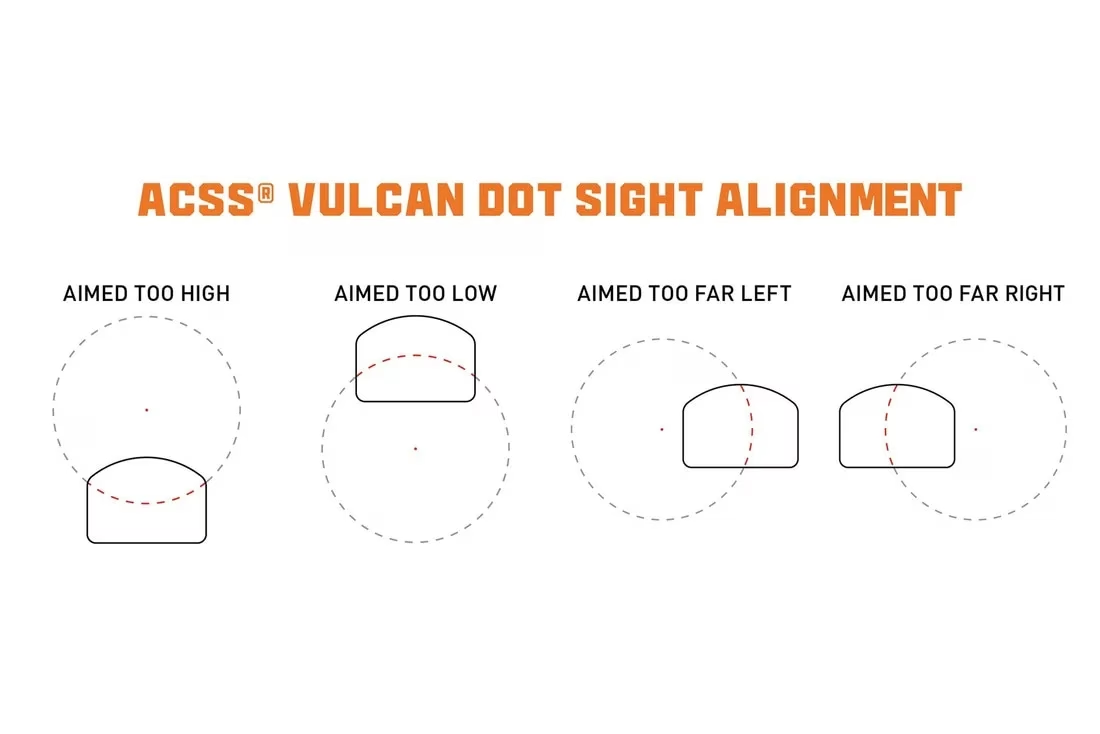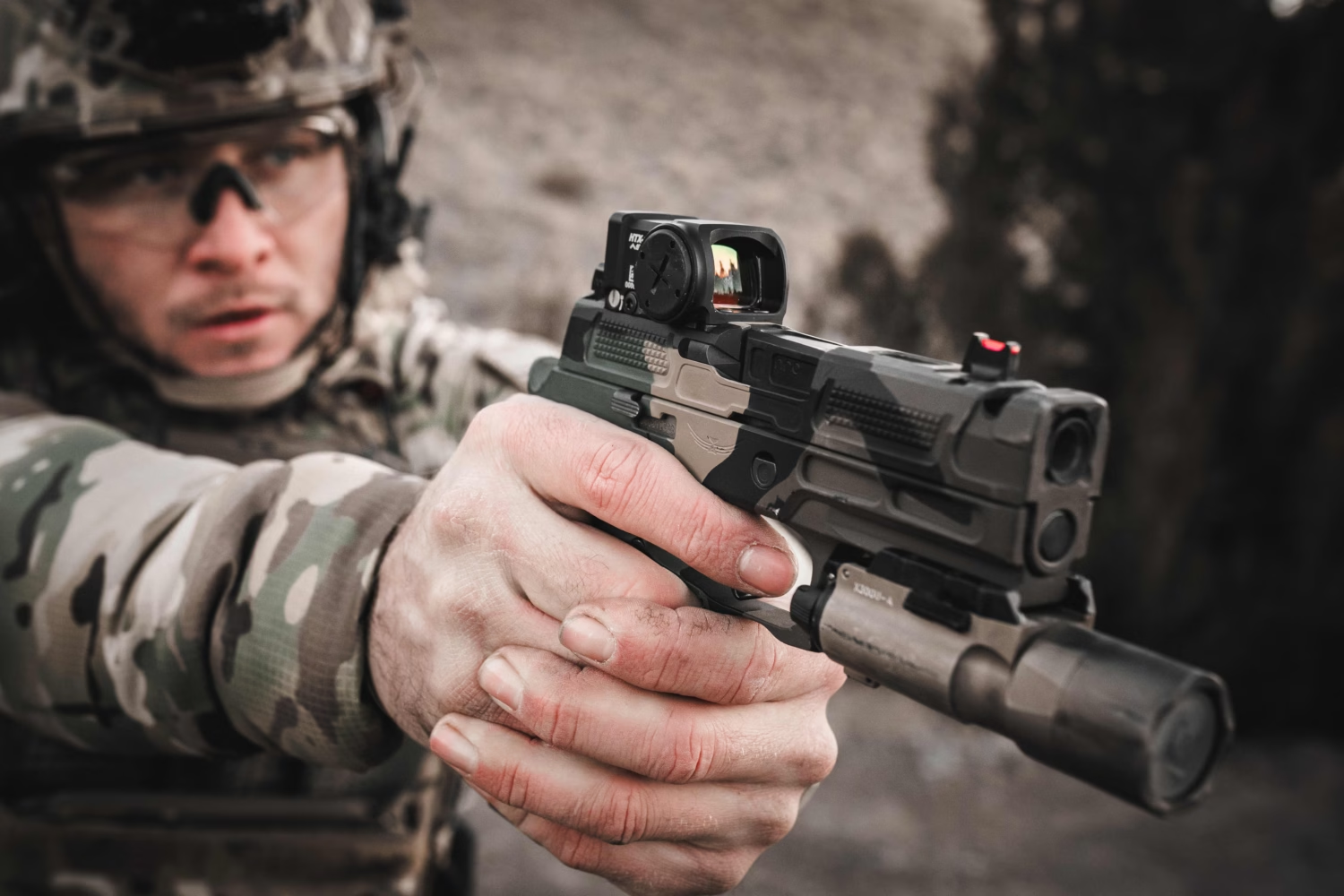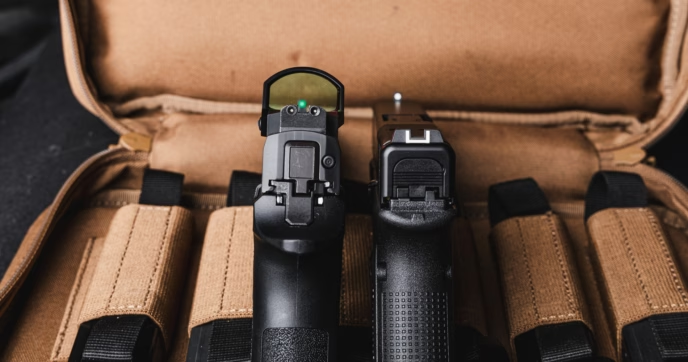An optic is only as useful as the reticle inside it, and while traditional red dots and crosshairs have served well for decades, new demands from competitive marksmen, law enforcement officers, and armed citizens have pushed the industry to innovate.
Among the most groundbreaking of these innovations is the ACSS® Vulcan® system, a refinement of the already revolutionary ACSS reticle family. By combining speed, precision, and situational awareness, the Vulcan and Vulcan Dot reticles have redefined what is possible within the compact footprint of a reflex sight.
To fully appreciate what the Vulcan represents, it is important to understand where it came from. The Vulcan is not an isolated creation, but rather the culmination of years of research and refinement within the ACSS (Advanced Combined Sighting System) lineage.
The ACSS philosophy has always centered around reticles that do more than just offer a static aiming point; instead, they integrate ballistic data, ranging tools, and rapid sight acquisition features into a single, intuitive design. The Vulcan is a new iteration of that philosophy, one retooled for the unique challenges of handgun marksmanship rather than rifle. It’s very effective at solving some of the most persistent challenges faced by micro reflex optics while setting new standards in both speed and accuracy.

The Evolution of ACSS
The ACSS, or Advanced Combined Sighting System, was born from a simple yet ambitious idea: a low-friction reticle that is easy to use, even under stress, but still highly functional across the full spectrum of ballistic uses.
Traditional designs often forced users to make compromises, whether in the form of limited precision at distance, cluttered fields of view, or reticles that performed well in one scenario but poorly in others. The ACSS was developed to bridge these gaps by creating reticles that are easy to learn, fast to use, and versatile enough to handle a wide variety of conditions.
The earliest ACSS reticles appeared in magnified optics designed for rifles, where they provided a combination of ballistic drop compensation, wind holds, and ranging tools without overwhelming the shooter with excessive markings.
The genius of the ACSS design was that it integrated this information in a way that felt natural to the eye. Chevron aiming points replaced simple dots, offering greater precision while naturally drawing the eye toward the tip. The chevron became a hallmark of the ACSS line. While cross or dot aiming points are forced to choose between speed and precision, the chevron can offer both, with a fine, sharp tip for precise marksmanship and a broad overall shape for faster, shorter shots.
Each ACSS reticle is different, but many also incorporate stadia lines or dots for holdovers at distance, as well as rapid ranging tools, wind hold marks, and more.
This design philosophy—placing essential information directly where the eye looks and eliminating unnecessary clutter—quickly gained traction. Over time, ACSS expanded into a wide variety of optics, from prism scopes to low-power variable optics and even red dot sights, each iteration refining the balance between speed and precision.
The Vulcan reticle is the culmination of this evolution, carrying the same principles into the unique environment of micro reflex sights and optic-ready handguns, where small windows, rapid movements, and the need for immediate sight alignment pose unique challenges.
Understanding Vulcan
At the core of the Vulcan system are two distinct but closely related designs: the ACSS Vulcan and the ACSS Vulcan Dot®. Both reticles were developed with the same purpose, but they cater to slightly different user preferences and applications.
The original Vulcan retains the traditional ACSS chevron aiming point, a sharp, triangular design that provides remarkable precision. Unlike a simple dot, which can obscure a small target at longer ranges, the chevron’s tip allows for exact aiming without blocking the user’s view of the target. The open design of the chevron also helps naturally draw the eye to the tip, accelerating sight alignment even under stress.
However, some shooters prefer the simplicity of a dot, especially when training familiarity or personal comfort leads them to favor a round aiming point. To meet this demand, the Vulcan Dot was introduced, replacing the chevron with a fine, precise dot while retaining the rest of the Vulcan system.
The most innovative feature of both versions, though, is the large outer circle that encompasses the reticle. This feature is not intended to be used for aiming, but rather as a rapid correction tool.

In the tight window of a micro reflex optic, losing the reticle after recoil or during a quick draw is a common issue. The outer circle acts as a guide, instantly informing the shooter of the reticle’s position. If the aiming point drifts off-center, the outer circle’s arc provides immediate feedback, allowing the user to correct their sight picture without hesitation. In practice, this means that reacquiring the aiming point becomes nearly instantaneous, a massive improvement over traditional designs that force the shooter to “hunt” for the dot.
Together, these elements create a reticle that is as effective in a high-stress, close-quarters environment as it is at extended ranges. The chevron offers unmatched precision, the dot provides familiarity and simplicity, and the outer circle ensures that sight acquisition is nearly foolproof. The combination is not only intuitive but also dramatically reduces the time required to transition between targets, recover from recoil, or align the optic after movement.
Solving the Micro Reflex Challenge
Micro reflex sights have become increasingly popular due to their compact size, light weight, and versatility. They are ideal for handguns, personal defense weapons, and even compact rifles where a minimal footprint is desired. However, despite their popularity, these optics come with inherent limitations that can frustrate even experienced users.
The most pressing challenge is the small window size. Because micro reflex optics prioritize compactness, the available viewing area is limited. This makes it more difficult to immediately locate the reticle, especially under stress or when recovering from recoil. While certain optics, such as the Primary Arms GLx® RS-15, offer larger than average viewing windows, they still remain modest compared to more traditional red dots.
Another common issue arises during rapid draws or transitions, where the user may present the firearm slightly off-angle and find that the reticle has disappeared from view. In demanding competitive environments or professional applications, even a fraction of a second spent searching for the reticle can be costly.
The Vulcan reticle system directly addresses these challenges. By incorporating the large outer circle, the design effectively compensates for the restricted window. Instead of searching blindly for the dot or chevron, the user immediately sees part of the circle, which guides them back to center. This reduces wasted motion, speeds up recovery, and ensures that the reticle remains usable even in imperfect presentations.
Another benefit is the training efficiency that comes with the Vulcan’s design. Many marksmen, particularly those just learning how to use a red dot optic on a pistol, can become frustrated by losing the reticle during live fire. The Vulcan system alleviates this by providing a forgiving and intuitive reference point, which in turn builds confidence and provides instant feedback during practice. As a result, the learning curve associated with reflex optics is significantly reduced, making them more accessible to a broader range of users.
In practical terms, the Vulcan system significantly reduces the primary drawbacks of mini reflex sights, making them much more practical for all applications. Whether in competition, duty use, or personal defense, the Vulcan reticle ensures that users spend less time searching and more time engaging with precision.
Vulcan reticles are available in most Primary Arms red dot sights as well as select Holosun optics. For a detailed review of Holosun optics with Vulcan reticles, check out our Holosun ACSS Guide.

The Game-Changer: Primary Arms® HTX-1™
The ultimate iteration of the Vulcan system is found in the Primary Arms® HTX-1, a red dot sight that combines the lessons learned from years of ACSS innovation with cutting-edge optic design. The HTX-1 is not simply another reflex sight with a Vulcan reticle; it is a holistic solution that eliminates many of the drawbacks traditionally associated with this class of optics.
One of the most striking features of the HTX-1 red dot is its relatively large window. By increasing the available viewing area without sacrificing durability or compactness, the HTX-1 makes reticle acquisition almost effortless. This is particularly important for users who train with both eyes open, as the expansive window enhances peripheral awareness while maintaining a crisp, clear aiming point.
Equally impressive is the low mounting profile of the HTX-1. Reflex sights can sometimes sit higher than desired, which affects natural point of aim and complicates co-witnessing with backup sights. The HTX-1 addresses this with a streamlined design that positions the optic at an ideal height, reducing the need for excessive adjustment and ensuring a comfortable, consistent presentation.
Of course, the HTX-1 comes equipped with the ACSS Vulcan Dot reticle system. Combined with the optic’s robust construction, advanced coatings, and user-friendly controls, the HTX-1 sets a new standard for what a reflex sight can achieve.
In essence, the HTX-1 is more than just another product release—it represents a milestone in optic design. By merging the proven advantages of the Vulcan reticle with a platform engineered to maximize usability, Primary Arms has created a sight that redefines performance expectations in its category.

Conclusion
The ACSS Vulcan reticle system represents the pinnacle of years of refinement in sighting technology. From its origins in the broader ACSS family, it has inherited a design philosophy focused on speed, precision, and intuitive usability. The Vulcan and Vulcan Dot reticles take these principles and apply them to the unique challenges of micro reflex sights, solving long-standing issues like limited window size and difficulty reacquiring the reticle under stress.
By combining the precision of a chevron or dot aiming point with the innovative guidance of the outer circle, the Vulcan ensures that shooters can operate with confidence in both close-quarters and long-range scenarios. When paired with the Primary Arms HTX-1, these advantages are magnified, resulting in an optic that stands apart from the competition.
Ultimately, the Vulcan reticle technology is not just another incremental improvement. It is a transformative leap forward, offering solutions to real-world challenges that shooters face every day. Whether for competition, duty, or defense, the Vulcan represents the future of reflex sighting systems, delivering a balance of speed, precision, and reliability that is unmatched in the industry.

